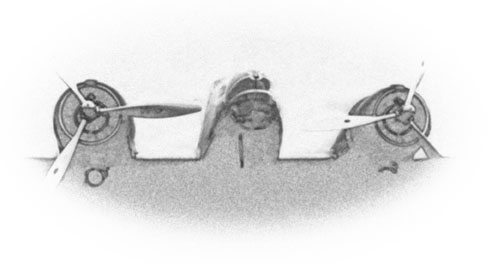We took off from Tonopah,
Nevada at 1145, January 29, 1943. We climbed through an overcast
to 9,000 feet and on top of the overcast for approximately one-half
hour, then flew between two layers of overcast.
– Excerpt from “Report On Crash B-23
#9052” by copilot
James V. Kelly, 2nd Lt., Army Air Corps.
|
|
| In July 2000, 20 TIGHARs spent a week learning about, and putting
into practical application, the principles and techniques of aviation archaeology.
This was the first time that TIGHAR had offered our popular Introductory Course
in Aviation Archaeology and Historic Preservation immediately followed by
a Training Expedition to an actual historic crash site. The faculty was
made up of TIGHAR’s executive director Ric Gillespie and archaeologist Tim
Smith (TIGHAR #1142CE). Bill Carter (TIGHAR #1722CE) provided invaluable
local logistical management while expedition veteran John Clauss (TIGHAR
#0142CE) kept the field operation running smoothly. |
Started to encounter
icing conditions. In a short while we lost our radio receiver
and tried to climb above overcast. Icing became pretty severe
and we were [able] to obtain only 18,000 feet, which did not put
us above the overcast except at rare intervals. It became evident
that we were unable to maintain that altitude. Spotted a hole
off to our left which we went down through.
– Excerpt
from “Report On Crash B-23 #9052” by pilot Robert R. Orr,
1st Lt., Army Air Corps.
|
|
|
After two days
of classroom work in Boise, Idaho the students convoyed in two large
vans to a trail head in the Payette National Forest where they began
the five mile hike to a campsite prepared by a professional outfitter
near Loon Lake. About half a mile from the camp was the wreck of
Douglas B-23 “Dragon” serial number 39-052.
Roughing
it at Café Loon Lake. Photo courtesy Nancy Ballenger.
|
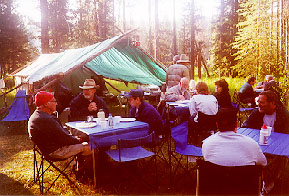 |
|
After we lost our altitude
we noticed we were flying over a town.... We circled for fifteen
minutes looking for a field to make an emergency landing, but
we could not due to a blinding snowstorm.
– copilot
Kelly
|
|
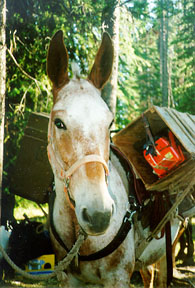 |
Summer in the
high country … our campsite was situated beside a clear mountain
stream that fed the lake where moose waded lazily in the early morning
mist. Deer carelessly meandered through camp and the surrounding
hills often echoed back the brays of the outfitter’s mules.
Possible
new Earhart Project team member? TIGHAR photo by R. Gillespie.
|
|
The snow was so blinding
it was unsafe to continue at low altitude. So we started climbing
and icing.... Continued flying northeast in hope we would break
out of the storm area. Unable to do so. Climbed to 19,600 feet
and managed to climb above snowstorm, but continued to have light
icing. Became impossible to maintain altitude and started to lose
altitude. Gave order for men to put on parachutes and prepare
to leave plane.
– pilot
Orr
|
|
|
Our first day
“on the airplane” was spent gridding off the site and
beginning the mapping process under Tim Smith's direction. What
at first had looked like a jumble of wreckage soon began to resolve
into a coherent image of frozen violence.
Frozen
violence. TIGHAR photo by R. Gillespie.
|
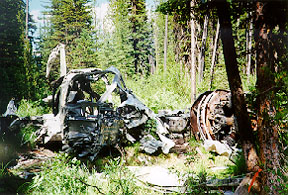 |
|
Someone then spotted
a hole in the ceiling and a clearing which turned out to be a
lake completely encircled by mountains and trees. Lt. Orr then
ordered us to take off chutes and prepare for a crash landing.
... The ceiling was getting lower all the time and the right engine
had caught fire.
– copilot
Kelly
|
|
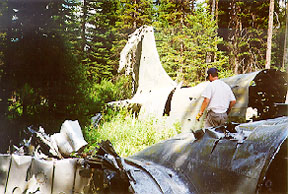 |
To our surprise
we discovered that the trees that had been sheared off by the careening
bomber 57 years ago still stood among the newer growth. Accordioned
wings and scattered control surfaces traced a trail from the shoreline
through the woods to the battered but largely intact fuselage.
Horizontal
tail surfaces and wings outboard of the engines were shorn from
the fuselage, absorbing most of the impact as the aircraft came
down through the trees. TIGHAR photo by R. Gillespie.
|
|
Made one circle over
the lake, below the level of the hills surrounding and decided
to attempt landing on the lake which was rapidly closing in. Still
unable to get the flaps to operate. Made one pass at the lake,
but due to the fact that the flaps would not go down, overshot;
managed to make another circle as low as possible. Still unable
to get flaps to operate. So was unable to set down in the small
area of the lake. Cut switches and mushed into the tops of trees
at the south end of the lake which bent before snapping, easing
us down but stripping wings from plane outside of engine nacelles.
Plane came to stop 50 yards from edge of lake. Fuselage intact
except for bombardier's compartment which was completely demolished.
Climbed out of plane, administered first aid, and prepared for
our stay.
– pilot
Orr
|
|
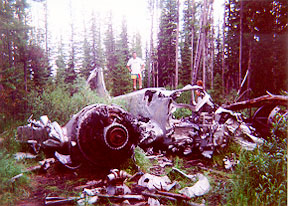
|
Everyone was
much moved by the feeling of authenticity and immediacy conveyed
by the crash site, but that first night, while we sat around the
campfire reliving the day, we came to the realization that something
was wrong. We had all seen photos of the wreck taken the year before
by Craig Fuller (TIGHAR #1589C) of Aviation Archaeological Investigation
& Research (AAIR) and we knew that the aircraft had been subject
to some vandalism and looting over the years, but the airplane we
had just examined was missing some parts – big parts and lots of
them – that had been present a year before.
In
this photo, taken a year before, the fuselage was still intact. Compare
with previous photos, in which large sections have been cut out,
including the cabin door, gunner’s windows, a substantial portion of
the belly and a complete bulkhead assembly, thus destroying the structural
integrity of the fuselage. Photo courtesy Bill Carter, TIGHAR #2313CE. |
|
Crew was all intact.
The only injuries at the time was that of Pilot Orr who had cut
his hand, S/Sgt Hoover cut his leg and hand. Men proceeded away
from plane, a fire was started in a low clearing where there was
not much snow.
– passenger
Cpl. Earl J. Beaudry
|
|
|
The next day we took
a close look at the recent damage. Not only were major portions of the
structure missing, but whoever had removed them had done so with power
tools and surgical expertise. In coordinating our proposed expedition
with the local office of the National Forest Service no one had said anything
about a salvage operation, especially one so recent that little piles
of aluminum shavings still lay undisturbed where great chunks were cut
from the fuselage. When we concluded our survey of the site and headed
back to civilization a few days later it was with a determination to find
out who had done this.
Click
here to go to Part 2 of this report, where we’ll learn what happened
to the eight-man crew of #9052 after their miraculously safe arrival in
the middle of a wintry nowhere, and we’ll track down who it was that cut
up one of the most intact surviving World War II crash sites in the United
States – and why.
|
|
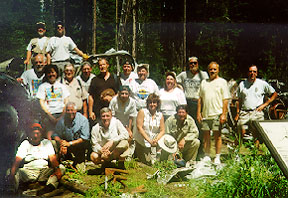
The
TIGHAR Loon Lake Archaeological Survey Team. L to R., front row:
Rick Jali #1875CE, Skeet Gifford #0001CEB, Exec. Dir. Ric Gillespie,
Nancy Ballenger #2315CE, Megan Fisher #2339CE, Kenton Spading #1382CE.
Middle row: Tom Roberts #1956CE, Maria Magers #2196CE, Fred Spading
#1383CE, Nick Murray #2356CE, John Humphreys #0206CE, Bill Carter
#2313CE, Veryl Fenlason #0053CE, Margot Still #2332CE, Tim Smith
#1142CE, Lee Kruczkowski #1821CE, Walt Holm #0980CE. Back row; Roger
Kelley #2112CE, Andrew McKenna #1045CE. Not shown (taking photo)
John Clauss #0142CE. TIGHAR photo.
|
| Special
thanks to Margot Still (TIGHAR #2332CE) and Craig Fuller (TIGHAR #1589C)
for their excellent historical research on B-23 #39-052 and to Pat
McGinnis at Boeing for her assistance in obtaining historical photos
of the B-23 airplane. Special thanks also to Bill Carter (TIGHAR #2313CE)
for his outstanding organization of Idaho logistics for the course
and expedition; to archaeologist Tim Smith (TIGHAR #1142CE) for his
expertise and guidance; and to John Clauss (TIGHAR #0142CE) for his
solid support in the field (as usual). |
|
|

